
PRO TESTED AND PROTOTYPED
Our ride was only two days; we were curious how long-term testing for Frodeno first, then Kienle and Carfrae, fared; what unique obstacles they encountered as applied to tri. So we spoke with SRAM pro liaison Alex Wassman.
"We got Jan the first test units, as he, other than Michellie Jones, has been the longest athlete with us, since 2007, before his Olympic success. Plus he's open to technologies," Wassman said.
We also spoke to reigning Hawaii Ironman World Champ Kienle to get his general thoughts in advance of this weekend's Ironman 70.3 World Championship, where he, Frodeno and defending 70.3 World Champ Javier Gomez will be running eTap on their bikes.
More: Ask A Coach: Are Power Meters Worth It?
"With the TT bikes of today, they're aero, but it always comes with pain in the ass cable routing, and with the crazy cables and angles comes the chance of something malfunctioning, especially the chance of a cable breaking or being cut while traveling. I've always been in fear of that," Kienle said. "So now it's nice with the wireless to forget about all that. Plus it gives frame producers greater chance to create better aero shapes without cables and housing in mind."
Kienle is right, especially when you consider that, as was previously mentioned, Canyon is now building bikes with only electronic cable capability; you can't run mechanical in a Canyon TT if you wanted.
Kienle continues: "And for travel, with no cables apart from brakes, it's so easy to now just remove the bar," Kienle added.
Functionally, he's noticed a few things.
"To be able to shift on the basebar and the extension is great. Everyone's different, and you can just put the button where you like. Some shift will want to shift with their thumbs in front of the extension, some with the ring finger in the middle of the shifter. For me, going up a slight hill like a 5-percent grade, I like to grab the extension further back, so that's where I put it."
"And you can shift and brake at the same time, setting up a corner," he adds. "It's cool. It's seconds or fractions of seconds, but hey--that's our sport."
PRICING
...looks like this (in USD), with mechanical parts and eTap components parsed out. Between the two, not much price variance. But it certainly is a premium group, and priced accordingly.
SRAM RED Road Mechanical Components
- 11-speed 11-28 cassette $279
- RED Exogram 53?39 Crankset $451
- RED Front Brake Caliper $142
- RED Rear Brake Caliper $142
- PowerLock 11-Speed Chain $48
- GXP English Bottom Bracket $36
Subtotal $1,098
SRAM RED eTap Components
- Right Shifter/Brake Lever $290
- Left Shifter/Brake Lever $290
- Front Derailleur with One Battery $370
- Rear Derailleur with One Battery $590
- Charger Power Pack (wall or USB chargeable) $70
- USB stick $50
Subtotal: $1,660
Complete eTap Road Groupset Total: $2,758 (2,691 Euro, 2059 Pounds, incl. VAT)
And for triathlon?
SRAM RED TT Mechanical Components
- 11-speed 11-28 Cassette: $279
- RED Exogram 53?39 Crankset: $451
- BL990 Carbon Aero Brake Lever Set: $157
- RED front brake caliper $142
- RED rear brake caliper $142
- PowerLock 11-speed chain $48
- GXP English bottom bracket $36
Subtotal $1,255
SRAM RED eTap Components
- Blips (quantity four), 650mm Cable Length: $200
- Blip Box: $300
- Front Derailleur with One Battery $370
- Rear Derailleur with One Battery $590
- Charger Power Pack (wall or USB chargeable) $70
- USB stick $50
Subtotal: $1,580
Complete eTap Triathlon/TT Groupset Total: $2,835 (2,785 Euro, 2,140 Pounds, incl. VAT)
eTap vs. Di2 vs. EPS
Comparing the three electronic groups offers distinct variances.
The shift logic is the industry's best. Despite not doing a swift gear "dump" the speed makes sense. We didn't have a problem with the speed at which shifting moving across the cassette range.
For triathlon, eTap is clearly the most integrated; there are no electronic "levers" or button pods to bolt onto the end of an aerobar extension; rather, it's a blip lever affixed wherever you like. Ergonomically, SRAM wins.
And in weight? We aren't sure whether Shimano's stated weights included cables, but look to do a comparison when we get all pieces in. But on its face, the lack of a bar end "shifter, whether a pivoted or a button that's bolted into the extension is a saving versus the invisible Blip buttons.
With Canyon, Felt or Specialized with the Shiv's Fuelselage serving as a potential Blip Box hidey hole, hiding all the cables is indeed possible for a super clean aero presentation. But from a practicality standpoint, SRAM notes having its functionality is a key benefit, and it's thus better to have the Blip Box exposed, making it an on-the-fly barrel adjustor at your fingertips. It's amazing to look at the front and rear derailleurs with no wires coming out of each, but to be able to lock in your shifting during a wheel change is nice, too.
"Jan really pushed it for us to hide it," Wassmann tells LAVA. And Jim Felt is no different; he wanted to use his solutions to hide it. For Jan, we had it in the stem in Frankfurt and in Oceanside with an SLA drinking system, it was in a dry compartment that rotated with the steering column. I do think we'll see a lot of cool solutions.
As mentioned, the wires themselves serve to extend the Blip Button's radio capacity, allowing the Blip Box to be tucked away.
- 3
- of
- 3








Discuss This Article